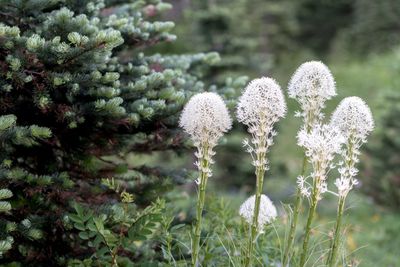Common Beargrass Plant Info
A nature hike around western North America in late spring to early summer, you may see fields of slender, arching foliage with huge, fluffy, white flower heads. The plant is beargrass (Xerophyllum tenax), and the name stems from the fact that young bears seem to like to eat the tender stems. The plant is protected in some of its native range, so if you want to start growing beargrass in gardens, it is best to use seed or transplant an offset from a garden buddy’s plant. Beargrass has slender grass-like stems that may get 3 feet (1 m.) long. It is an evergreen perennial that is found in open woods, sunny clearings in dry or wet soil. It is primarily in cool, subalpine zones. The flowers occur on a thick, fleshy stem that can get up to 6 feet (2 m.) in height. The flowers are a thick cluster of scented, white, tiny blooms. Depending upon which cultivar, the scent is reminiscent of lilacs or musty old socks. The fruits are 3-lobed dry capsules. As the plant matures, it develops offsets that can be harvested for propagation. The seeds should be harvested fresh and planted immediately or dried and stored in a dark, cool location. Beargrass is a favorite of not only bears but rodents and elk, and it also attracts pollinating insects.
How to Grow Beargrass
Growing common beargrass from seed is very straightforward but plants won’t produce flowers for a couple of years. Propagation by rhizome is quicker and results in flowers the first year. If you have harvested seed, it will need stratification before it will germinate. You can do this in your refrigerator for 12 to 16 weeks or plant the seed in the fall and let nature do the process for you. Sow seed at a depth of ½ inch (1.5 cm.) deep directly to the garden bed in late fall. If sowing in spring, pre-soak seed in distilled water for 24 hours to encourage germination. To harvest offsets, cut carefully around the parent plant where the offset is attached. Excavate under the little plant and use a sharp, clean knife to sever the pup. Make sure roots are attached to the offset. Plant immediately in humus-rich soil with plenty of grit added for drainage.
Common Beargrass Care
Newly planted seeds should be watered sparingly to prevent rot. Seeds outdoors will usually receive enough rainfall from natural spring precipitation. Provide young plants average water but they do not need fertilizer. Use organic mulch to prevent competitive weeds and conserve soil moisture. Mature plants will benefit from the removal of the spent flower head. Prune off any damaged leaves. Beargrass in the wild is often a pioneer species that appears and then goes away when taller plants start colonizing. It is also one of the first plants to appear after a fire. The plant is having a hard time surviving in the wild due to habitat loss and logging. Start some seed and increase the population of this wild plant that is important to many insect and animal species.
